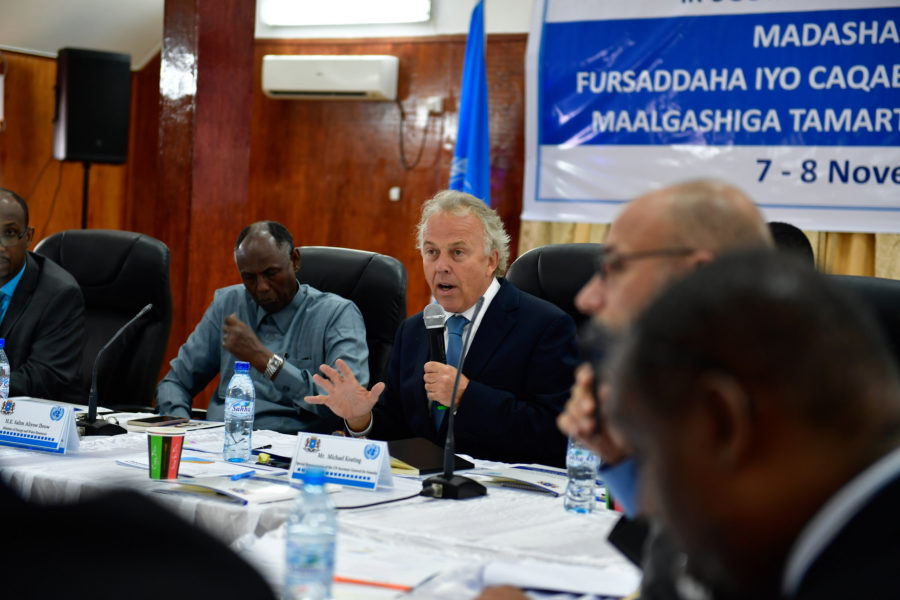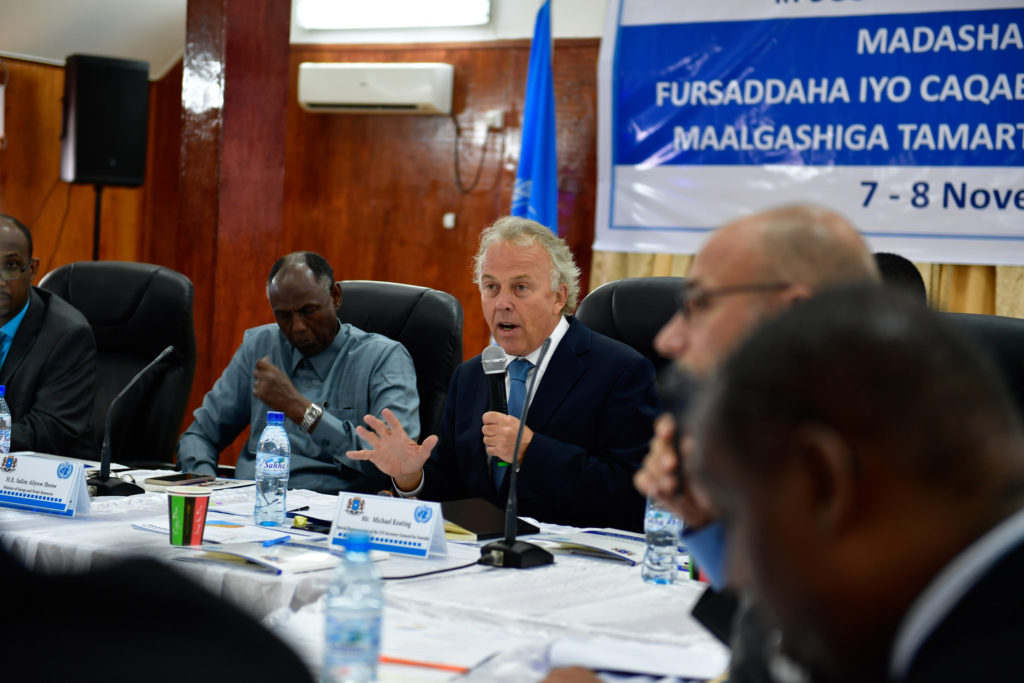Blended financing key to achieving sustainable energy investment in Somalia-UN expert

A grant essentially is a 100% loss investment. You don’t expect any return on it.

The recently concluded Sustainable Energy Forum in Mogadishu which brought together government, investors and private sector players and the UN called for a strong public-private sector partnership to build synergies in realising a sustainable energy framework in Somalia. Goobjoog News Editor T. Roble spoke with UN expert on sustainable energy Andrew Morton on key issues and ways of lighting up Somalia is a sustainable way.
Goobjoog News: What does this forum aim to achieve?
The specific aim is to prepare the ground for the more integrated and stronger efforts of increasing access to energy that means planning the work on policy of legislation on international projects, on public private partnerships projects and how an organized manner to bring in large scale investment into the sector both in the national economy, the Diaspora and the international community. Essentially it’s a step up the pace on access to energy in Somalia. So we have essentially key players in the room who are discussing the strategies and the need and the wants and everybody is well informed. So 2017 could be described as the year of questioning, thinking and planning. In 2018 we wish to move on investment and doing.
FDI investment especially in sustainable energy in Somalia remains very minimal. Are we likely to see upward movement as a result of this forum?
There are two levels of direct investment and even indirect investments still works. The first is that money needs to come into businesses which sell energy products and that actually can happen relatively quickly. We are talking about bringing working capital to companies they can buy material which is then redistributed for example in Somalia. That can happen in a matter of months to years and there are businesses already here, that are thirsting for working capital. So that can happen on a really quick scale.
There is also one of the ways to the easiest; get the larger numbers of access so each house hold spends $50, $100 just get each extra household the first rung on energy ladder to get them access. The larger FDI is essentially big finance going into infrastructure and that takes longer because of the scale of the money involved and the risks, complication of tech engineering and legalities and due diligence etc and design. So we’ll see that the work starting now, things being built will take in some case years to develop because we know everyone is impatient but what we are looking at is strategy where we build things in phases but we have a vision to get to a different level.
As an example, right now you have essentially an economy which is run on diesel generators and very basic grids with very poor metering. There are many things can be done to improve: intelligent metering, better distribution, better connection and monitoring of the systems. These improvements can make as big a jab in price and quality as adding solar energy.

Let us get those things done first. Then you look at injecting things like large scale solar energy which means you need to deal with technical challenges and you need to look at technologies such as bringing glass cab batteries, integrating wind extra. The really big job which is what international community and leadership is looking for is some cases is to move out of essentially the diesel economy. For example for Mogadishu it is unthinkable in the long term that the capital city relies on 50 diesel generators or 100 diesel generators.
What you need to move to is power plants which are efficient and large scale and can integrate large scale renewables. And given the position here, the most logical alternative is to move to natural gas. So this is an example of what we would have as a vision. You can imagine a few years from now if everything goes well that we have natural gas terminal. We have a natural gas power plant and we have a lot of gas coming into the country which means the price of bottle gas will go down.
There is large scale energy low price being sold to distribution companies and we have a grid which is capable of absorbing large amount of solar and wind. We are many years and millions of dollars away from such a situation but that is the logical end conclusion of vision if you want efficient, reliable and low cost energy to underpin the Somali economy. One of the things we need to sort out is at this stage is lack of regulation because you cannot inject this scale of finance and complexity technically into a chaotic situation where you have overlapping grids, low quality safety standards, agreements who puts what where for power and regulations.
The private sector would be encouraged to invest but also join in the regulatory framework because at the moment is set in introduction. They are making money but it’s a tiny fraction of what possible if the energy economy in Somalia takes off. I think a jump of 10 times is completely viable within 5-10 years and probably 10-30 times every generation. So we are at the start of the energy economy of Somalia. So we need to set up generations of developments the right way.
Talking of inherent risks either in terms of security or fiduciary risks, do you think investors would be willing to take the risks and put their money in this kind of investment and environment?
This is where the dichotomy between the foreign aid economy and investment economy needs to be resolved because we are not asking the private sector to just to come in take outlandish risks because the benchmark we have at the moment is, we have a large amount of money being sunk in to things which provide zero return on investment. 100% loss.
A grant essentially is a 100% loss investment. You don’t expect any return on it. So we have several billions of dollars going into that and at the same we are asking these other guys to get 15-20% return on investment. In between is the public private partnership what I call blended finance. We have projects which are private sector led but they have support not to completely subsidizing but to help them start to reduce the risk, to bring down the cost of borrowing, to provide some form of insurance when the normal insurance market would not help them. This is the way, the cost effective way of protecting the private sector from the worst risks. There are many mechanisms in which you can do that and that is part of the fine detail we talking about here.
The international community, the major donors, they are ready to do this. They do this in other countries but such instruments need to be designed carefully and executed and rolled up with care to avoid distorting the market or unfair favouritism towards one company or another or creating a false bubble where people chase incentives rather than real economy. So it requires work but it has been done and it can be done and it’s much cheaper than doing everything through grants and more realistic than asking the private sector to do everything.
Somalia relies on biomass fuel and diesel engines as main source of energy and as it has been said, the country has the potential for wind and solar energy. As an expert in this field, which direction would you be advising Somalia to take to attain sustainable energy sufficiency?
There has been a sea change in the last generation between the different types of renewables. So the first thing is that wind and solar the prices have dropped dramatically which means they are much more competitive compared to hydropower than it used to be. Now the actual hydraulic resources of Somalia on hydro-power are very limited. So I would see them as a potential minor player in some areas. The real potential is in solar and in wind.

Wind is more technically complex to build, to maintain and to integrate into a grid than solar. Right now the big push I am recommending on renewables is on solar. The challenge is to integrate that power into a grid which doesn’t respect the time of solar power generation. Everybody wants to turn on lights when it’s dark, not when there’s light.
The challenge is to bring the difference between the supply and the demand which may be evening or happen at the highest time when the clouds are above. That requires a system of integration and that’s where modern fossil fuel system can play that balancing role and that’s where modern tools such as big batteries can play a role.
So the future I see is solar plus diesel plus gas plus batteries and in later wind coming in; the major projects once we have some of the basics in place. So the first phase I believe will be solar and modern grids.
The African Development in its Energy Needs Assessment and Investment Programme 2015 proposed an ambitious $800m energy investment programme in Somalia. In light of this forum, could you shed light on whether you’re integrating the same or this is a different direction?
I don’t speak for the African Development Bank but it is all part of the same drive. When I talk about hydro dot million, we’re talking about potential investment scale particularly on lending. The infrastructural needs of Somalia’s cities, ports and industries energy wise are in the order of several billions. In the rest of the international community member countries, most of such infrastructure is financed with credit, with debt.
For the purpose of Somalia no limit to the amount of debt available once you qualify. It is all about qualifying for the debt and credit that is out there and making sure that its costs is as low as possible. So for me the first priority is not just to secure items in millions, is to demonstrate that we can get credit in for 10, 50, 100 and then we have the experience and more confidence to come in, to have more competitors providing more credit, competing to who gets the lion’s share. So it’s the same drive. African Development Bank lend and 20 can other international lenders if the market is going well.